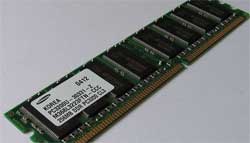Difference Between SRAM and SDRAM
 SRAM vs SDRAM
SRAM vs SDRAM
SRAM or (Static Random Access Memory) is a type of computer data storage that does not need frequent refreshing. Meaning, the information from an area of computer memory does not need to be read and rewritten to the same area every so often, thus gives it a name static. While the SDRAM or (Synchronous Dynamic Random Access Memory) is a type of computer storage that needs frequent refreshing but has a synchronous interface. Meaning it refers to the microprocessor clock before it responds and then synchronized with the computer’s system bus.
Since SRAM does not need frequent refreshing, its access speed range is faster than SDRAM which access speed range depends on the clock speed. But, although faster access time is better, user-perceived performance is based on coordinating access times with the clockÃs cycle. Access time consists of latency and transfer time. Latency is the time coordinating the signal timing and refreshing the data after reading it. However, people more often prefer using the SRAM due to its ease of interfacing. There are no refreshing cycles and the addresses and data buses are directly accessible.
But, how about their capacity? SRAM uses the kind of memory called flip-flops which are used for digital data storage. Its memory contents can be retained for as long as there is DC power. While the SDRAM uses the kind of memory cell called capacitors which needÃs to be refreshed periodically. But since there are a few transistors in a flip-flop memory, it occupies a lot more space than a capacitor. The DRAM memory can pack several gigabits on a DRAM chip while the SDRAM memory can only pack several tens of mega bits on its chip.
Another thing we should consider is their power consumption. Considering that SDRAMs needs to be refreshed every now and then, it is given electronic charge every few nanoseconds. And for that it takes more power consumption. Temperature range also somehow contributes with the power consumption of these memories. With SRAMs the power consumption is completely stable between -55 C and 125 C. Unlike with SDRAMs as well as to the other type of DRAMs, the high refresh rate at higher temperatures consumes pretty much a lot of power, even if the memory is not accessed.
Lastly, we all know the rules in the world of technology. The faster and simpler it is, the more expensive it gets. As SRAM is considered to be still faster in speed, it is also continuously to be charged more expensive than SDRAM. However, we should always remember to choose what’s best that fits our needs.
Summary:
1. SRAM is static (doesnÃt need power-refreshing) while SDRAM is dynamic (needs power-refreshing periodically).
2. SDRAMÃs access speed is clock dependent while SRAM accesses directly.
3. DRAM memory can pack several gigabits on a DRAM chip while the SDRAM memory can only pack several tens of mega bits on its chip.
4. SRAMs power consumption is stable while SDRAMs is higher due to refreshing cycles.
5. SRAM is more expensive than SDRAM due to faster speed.
- Difference Between EIDE and SATA - February 3, 2010
- Difference Between HTM and HTML - January 27, 2010
- Difference Between Grey and White Matter - January 27, 2010
Search DifferenceBetween.net :
 Email This Post
: If you like this article or our site. Please spread the word. Share it with your friends/family.
Email This Post
: If you like this article or our site. Please spread the word. Share it with your friends/family.


“SRAM does not need frequent refreshing”
It doesn’t require refreshing at all.
“user-perceived performance is based on coordinating access times with the clock’s cycle”
Wrong. Complete B.S. A computer’s memory clock is in the high hundreds of millions of cycles per second. People can’t perceive that at all.
“However, people more often prefer using the SRAM due to its ease of interfacing.”
If by people you mean systems designers, sure, they prefer it because it has a simpler interface to the microprocessor or controller. If by people you mean users, they can’t perceive a difference and don’t get to make that decision anyway. SRAM is generally used for memory caches near the processor and not for any consumer memory devices. For those purposes, FLASH and types of DRAM such as SDRAM are always used.
You did not point out is that dollar for dollar, you get more than 1000x as much SDRAM memory as you would when buying SRAM memory. Static memory is very expensive.
SRAM is basically a technology for systems engineers. You discuss this like it might be a consumer technology and choice, but it isn’t. The only choice a consumer has is paying more for a microprocessor with a larger cache. Other than that, there is no choice for the consumer.
pls can.someone help me with a system engineering apps names or even a link to download them